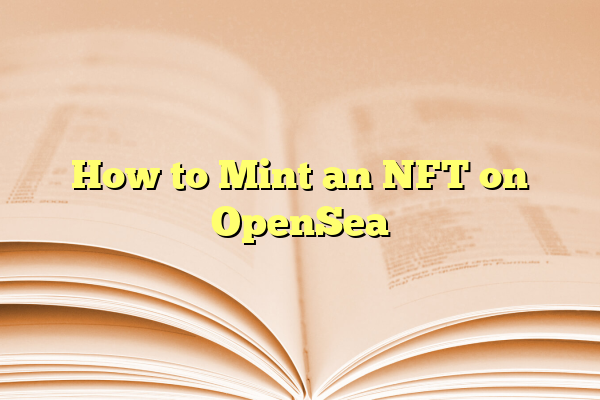
How to Mint an NFT on OpenSea
Minting a Non-Fungible Token (NFT) has become more accessible thanks to platforms like OpenSea, the world’s largest NFT marketplace. Whether you’re an artist, content creator, or entrepreneur, understanding how to mint an NFT on OpenSea is essential if you want to participate in the digital economy. In this guide, we’ll walk you through the steps involved, from setting up your wallet to listing your first NFT.
What Does Minting Mean?
Minting is the process of turning a digital file—such as an image, audio clip, video, or document—into a unique digital asset on the blockchain. Once minted, the file becomes a certified, tradeable NFT with recorded ownership history, often on the Ethereum blockchain.
Step 1: Set Up a Digital Wallet
To begin, you’ll need a digital wallet that supports Ethereum. One of the most recommended is MetaMask, a browser extension and mobile app that allows you to manage your crypto securely. Here’s how to set it up:
- Download MetaMask from the official website or app store.
- Create a new wallet and store your seed phrase in a secure location.
- Add some Ethereum (ETH) to your wallet. You can purchase it through platforms like Coinbase, Binance, or directly within MetaMask using integrated services.
Step 2: Connect Your Wallet to OpenSea
Go to OpenSea.io and click on the wallet icon in the top-right corner. Choose MetaMask or the wallet of your choice and follow the prompts to connect. Once connected, OpenSea will automatically generate your account using your wallet’s public address.
Step 3: Create a New NFT Collection
Before you mint your first NFT, it’s advisable to create a collection. Collections help organize your NFTs and are visually presented as galleries. To create one:
- Click on your profile image and select “My Collections.”
- Click “Create a Collection.”
- Add a name, description, logo, and relevant details.
- Choose the blockchain you wish to use (Ethereum or Polygon).
Step 4: Mint (Create) Your NFT
Now that you have a collection, you can start minting individual NFTs. Follow these steps:
- Navigate to your collection and click “Add Item.”
- Upload your digital file (image, video, music, etc.). Supported formats include JPG, PNG, MP4, and more.
- Enter a name and optional description for your NFT.
- You can add properties (like color or genre), levels, and stats that make your NFT more descriptive.
- Set your supply (typically 1 for unique NFTs), and choose if the NFT will be part of an unlockable content—special files that only the buyer can access.
- Click “Create” to mint your NFT.
Minting on certain blockchains like Polygon is gas-free on OpenSea, making it an ideal choice for beginners. Minting on Ethereum, however, may incur gas fees, which vary based on network congestion.
Step 5: List Your NFT for Sale
After minting, you can choose to keep your NFT in your collection or list it for sale. To do this:
- Click on your NFT and select “Sell.”
- Set your price in ETH. You can choose a fixed price or schedule an auction.
- Select the duration for which the listing will be active.
- Click “Complete Listing.” If this is your first sale, OpenSea may require you to initialize your wallet. This is a one-time transaction.
Once the listing is confirmed, your NFT will be available for purchase on the OpenSea marketplace.

Additional Tips for Success
- Promote your NFT: Share your listing on social media platforms and include relevant hashtags to attract potential buyers.
- Provide value: Consider adding unlockable content such as downloadable files, links to bonus materials, or even physical goods.
- Community Engagement: Join NFT communities on platforms like Discord, Reddit, or Twitter to connect with collectors and fellow creators.
Final Thoughts
Minting an NFT on OpenSea is a straightforward yet impactful way to protect, distribute, and monetize your digital creations. By following these steps and understanding the basics, you set yourself up for success in the fast-growing NFT ecosystem. Always make sure to keep your wallet secure and stay informed about blockchain trends and security best practices.
